Perennials
“Liriope Grass” has been added to your cart. View cart
Showing 1–16 of 26 results
-
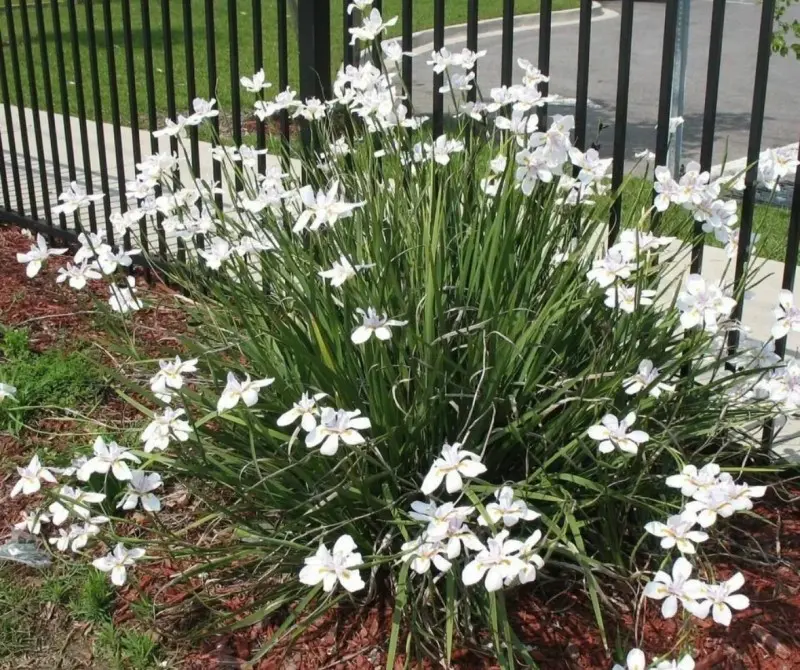
African Iris
$0.00Add to Lawn2'-4'Full sunPartial sunDeer resistantAfrican Iris (Dietes iridioides), also known as Fortnight Lily or Wild Iris, is a hardy perennial plant admired for its elegant, iris-like flowers and sword-shaped, evergreen foliage. Native to southern and eastern Africa, African Iris produces delicate white blooms with yellow and purple-blue markings, reminiscent of traditional irises. Each bloom lasts only a day, but the plant produces a succession of flowers over an extended period, especially in warm climates, often blooming in cycles every two weeks (hence the nickname "Fortnight Lily"). African Iris grows to about 2 to 4 feet in height and width, forming clumps of arching, dark green leaves. It is hardy in USDA zones 8-11 and thrives in full sun to partial shade. African Iris prefers well-draining soil but is adaptable to a variety of soil types, including sandy or clay soils, and is notably drought-tolerant once established, making it a resilient choice for low-water landscapes. Low-maintenance and durable, African Iris is often used in borders, mass plantings, and containers, where its tall, graceful leaves add texture and structure year-round. It can also be planted near ponds or in rain gardens due to its tolerance for occasional wet conditions. With its low water requirements, attractive flowers, and ability to withstand heat, African Iris brings beauty and versatility to a variety of garden settings, providing a touch of elegance with minimal upkeep. -
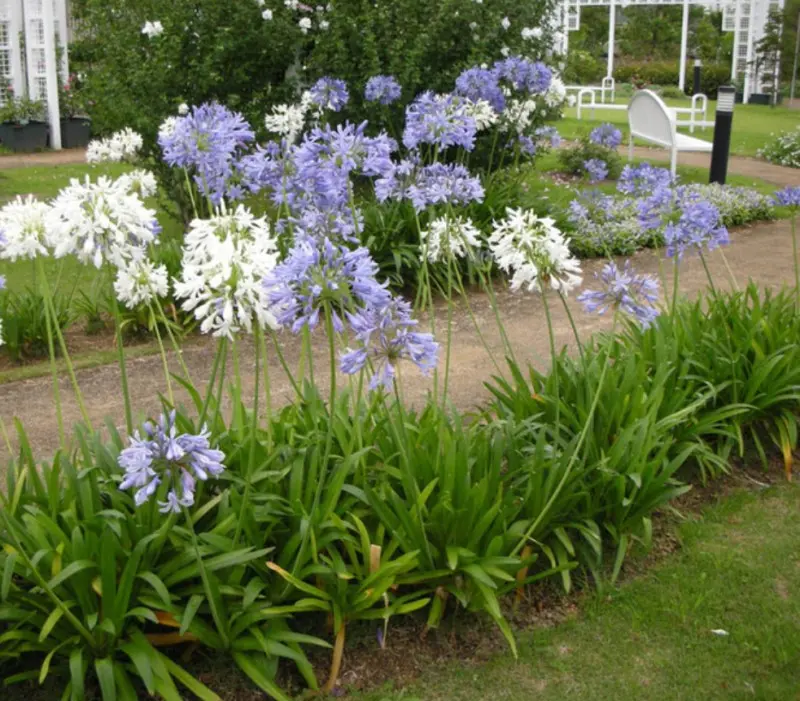
Agapanthus
$0.00Add to Lawn2'-3'Full sunPartial sunNot deer resistantAgapanthus, often known as Lily of the Nile or African Lily, is a striking perennial plant known for its tall, elegant flower stalks topped with clusters of trumpet-shaped blooms. Native to South Africa, Agapanthus produces vibrant flowers in shades of blue, purple, and white, typically blooming in mid-to-late summer. The plant’s long, strap-like, green leaves form a dense clump at the base, creating a lush foundation that contrasts beautifully with its towering blooms. Agapanthus thrives in full sun but can tolerate partial shade, especially in hotter climates. It performs best in USDA zones 7-11 and prefers well-draining soil, although it’s also moderately drought-tolerant once established. In colder regions, some varieties can be grown in pots and brought indoors during winter. Depending on the variety, Agapanthus can range from compact dwarf types (about 12-18 inches) to taller cultivars that reach up to 4 feet. With its architectural elegance, Agapanthus is popular in border plantings, mass plantings, and container gardens. Its flowers are highly attractive to pollinators like bees and butterflies, and the blooms are long-lasting, even suitable for cutting to enjoy indoors. Minimal care is required beyond occasional watering and fertilizing during the growing season, making Agapanthus a favorite for low-maintenance yet striking landscapes. -
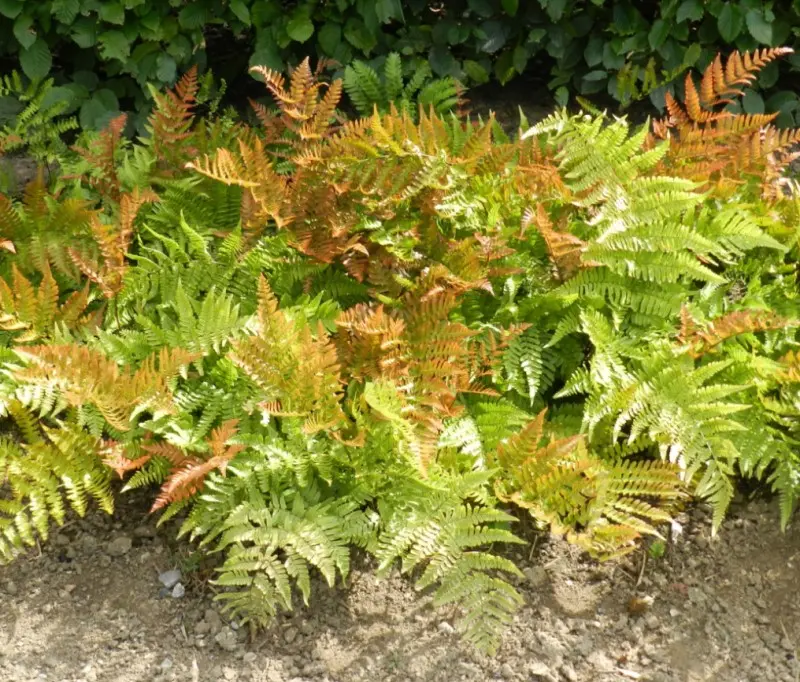
Autumn Fern
$0.00Add to Lawn2'-3'Full shadePartial shadeNot deer resistantAutumn Fern (Dryopteris erythrosora), also known as the Japanese Shield Fern, is a hardy, evergreen fern admired for its vibrant, coppery-red new fronds that mature to a lush green. This unique color-changing foliage gives the plant its name, as the fiery hues are reminiscent of autumn even in spring and summer. Native to East Asia, the Autumn Fern has a graceful, arching habit and reaches about 1 to 2 feet in both height and width, forming dense, tidy clumps. This fern thrives in partial to full shade, making it ideal for woodland gardens, shaded borders, or as an accent in low-light areas. It performs well in USDA zones 5-9 and prefers moist, well-draining soil rich in organic matter. While it does best in consistently damp conditions, the Autumn Fern is relatively tolerant of drought once established and can withstand brief dry spells. Autumn Fern requires minimal care, making it a popular choice for low-maintenance shade gardens. Occasional pruning of older fronds in late winter helps to freshen up its appearance and encourage new growth. Its bold color and texture make it an excellent companion to other shade-loving plants, adding both interest and depth to shaded areas. Whether used as a ground cover, in borders, or as a container plant, the Autumn Fern brings warmth and beauty to landscapes year-round. -
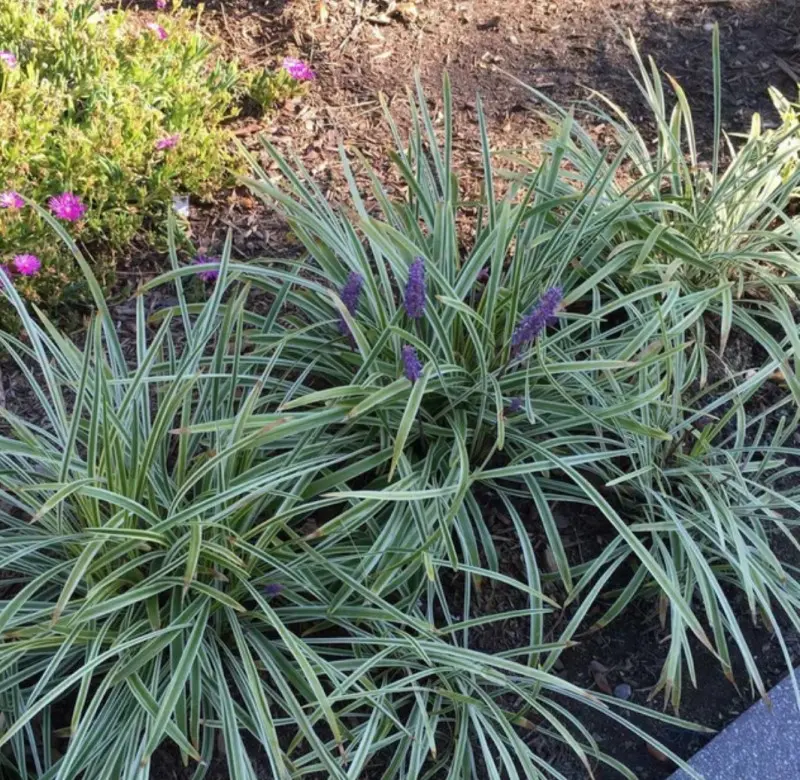
Aztec Grass
$0.00Add to Lawn1'Full shadePartial shadeNot deer resistantAztec Grass (Ophiopogon intermedius), also known as Dwarf Lilyturf or Silver Dragon, is a popular ornamental grass-like plant valued for its striking, variegated foliage. Its long, narrow leaves feature green and creamy white stripes that add a bright, textured element to the landscape. Although not a true grass, Aztec Grass belongs to the Asparagaceae family and has a clumping, low-growing habit, typically reaching about 12 to 18 inches in height and width, making it ideal for ground cover, borders, and adding contrast in garden beds. Aztec Grass produces small, delicate lavender or white flowers on short spikes in late summer, followed by small, blue or black berries that offer additional interest. Hardy in USDA zones 7-11, it performs well in both full sun and partial shade, though it benefits from some afternoon shade in hotter climates to prevent leaf scorching. It prefers well-draining, moderately moist soil and is moderately drought-tolerant once established. Low-maintenance and easy to grow, Aztec Grass requires minimal care beyond occasional watering and a light trim in early spring to remove any damaged leaves and encourage fresh growth. Its versatility, combined with its distinctive variegated foliage, makes it a beautiful choice for edging pathways, planting in shaded gardens, or enhancing containers. Aztec Grass brings both color and elegance to a variety of landscape styles, blending seamlessly with other plants while adding a unique visual texture. -
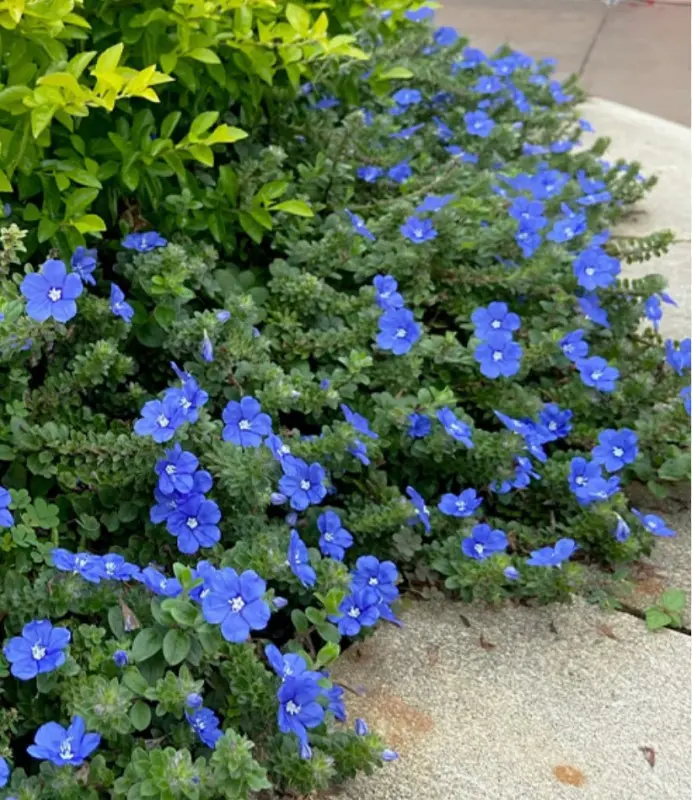
Blue Daze
$0.00Add to Lawn1'Full sunPartial sunNot deer resistantBlue Daze (Evolvulus glomeratus), also known as Brazilian Dwarf Morning Glory, is a charming, low-growing perennial prized for its delicate, true-blue flowers and silvery-green foliage. Native to tropical and subtropical regions of Brazil, Blue Daze produces small, funnel-shaped flowers that bloom continuously from spring through fall, making it a popular choice for adding vibrant color to garden beds, borders, and containers. Each bloom lasts only a day but is quickly replaced by new flowers, ensuring a steady display of color. Blue Daze typically grows to a compact height of about 6 to 12 inches, with a spreading habit that can reach 2 to 3 feet wide. This makes it an excellent ground cover or trailing plant for hanging baskets. It thrives in full sun, where its foliage and flowers reach peak vibrancy, and it is hardy in USDA zones 9-11. In cooler climates, Blue Daze is often treated as an annual, as it does not tolerate frost. It prefers well-draining soil and is both heat- and drought-tolerant once established, making it suitable for hot, dry climates. Low-maintenance by nature, Blue Daze benefits from light pruning to maintain shape and can tolerate a bit of neglect, thriving even in challenging conditions. Its resilient beauty, combined with its soft blue blooms and silvery foliage, adds a soothing, tropical feel to landscapes, garden beds, and patio arrangements. -
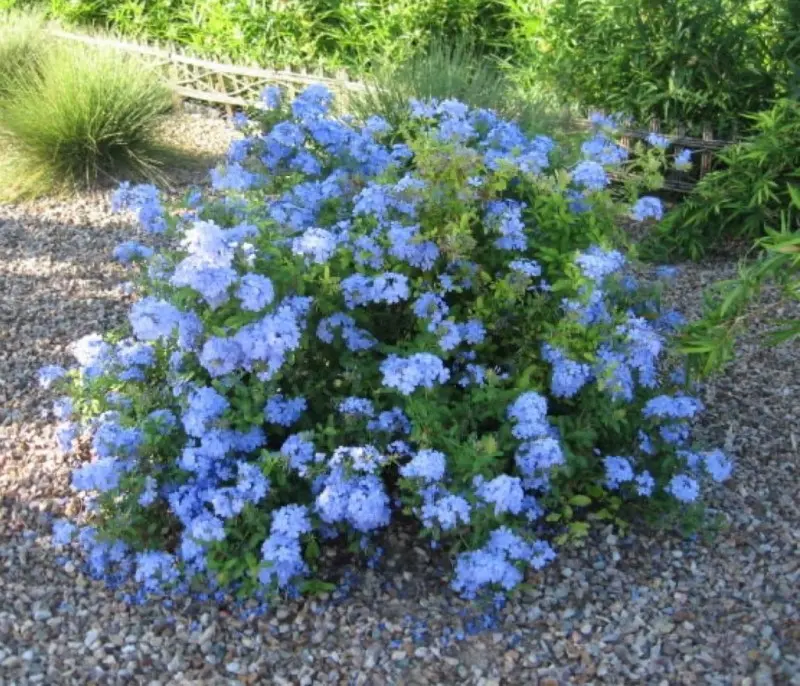
Blue Plumbago
$0.00Add to Lawn2'-5'Full sunPartial sunDeer resistantBlue Plumbago (Plumbago auriculata), also known as Cape Leadwort, is a lush, flowering shrub admired for its clusters of delicate, sky-blue flowers and graceful, arching stems. Native to South Africa, this plant blooms almost continuously from spring through fall, with flower clusters that resemble phlox. The blossoms create a soft, billowy display that attracts butterflies, adding a light and airy touch to gardens. Blue Plumbago can grow up to 6-10 feet tall and wide, making it ideal for informal hedges, trellises, or as a sprawling ground cover. It thrives in full sun to partial shade and performs best in USDA zones 8-11, where it can be evergreen. In cooler climates, it is often grown as an annual or can be brought indoors to overwinter. Blue Plumbago prefers well-draining soil and is both heat- and drought-tolerant once established, making it a popular choice for low-maintenance, water-wise gardens. Due to its sprawling nature, Blue Plumbago can benefit from light pruning to control its shape and encourage bushier growth. It pairs well with other sun-loving perennials and is perfect for borders, slopes, or cascading over walls. With its soft, blue flowers and resilient nature, Blue Plumbago brings a tropical, cottage-garden feel to landscapes and is a favorite for adding a splash of color and elegance. -
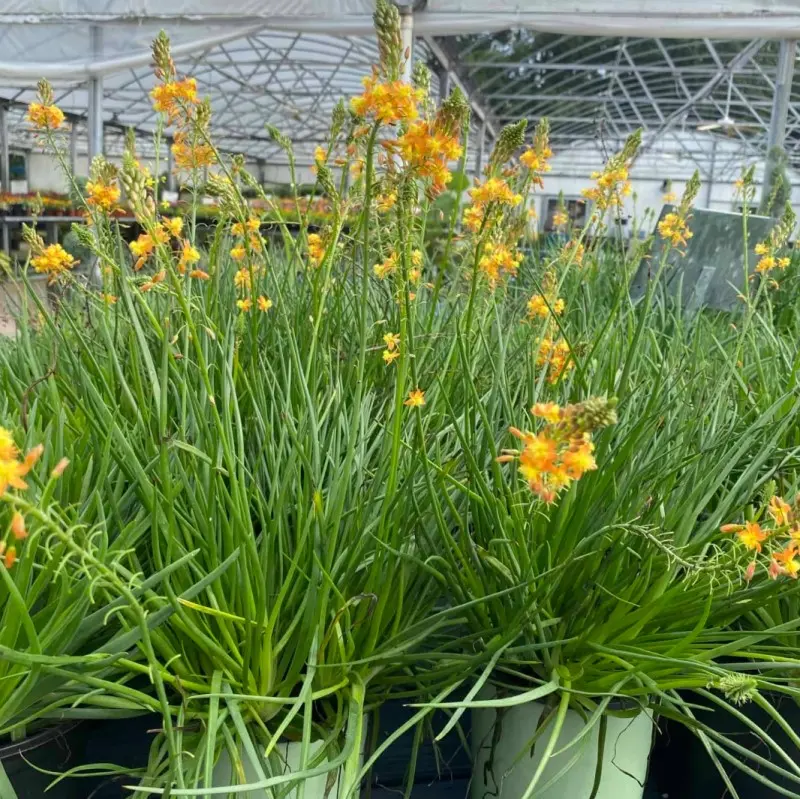
Bulbine
$0.00Add to Lawn1'-2'Full sun-Deer resistantBulbine (Bulbine frutescens), sometimes called Stalked Bulbine or Burn Jelly Plant, is a hardy, low-maintenance succulent known for its charming, star-shaped yellow or orange flowers that bloom in clusters atop tall, slender stems. Native to South Africa, Bulbine blooms almost year-round in warmer climates, adding consistent color to the garden. The plant’s narrow, fleshy green leaves grow in a clumping, grass-like form and contain a gel similar to aloe, often used for soothing minor skin irritations, giving it the nickname "Burn Jelly Plant." Bulbine typically grows 12 to 18 inches tall and wide, with flower stalks reaching up to 2 feet. It thrives in full sun to partial shade and is hardy in USDA zones 9-11. This plant is very drought-tolerant once established and does best in well-draining, sandy, or rocky soil, making it perfect for xeriscaping or low-water gardens. In cooler climates, Bulbine can be grown as an annual or in containers that can be moved indoors during winter. Ideal for borders, rock gardens, or ground cover, Bulbine attracts pollinators like bees and butterflies while being resistant to deer and pests. It requires minimal care, with occasional pruning of spent flower stalks to encourage further blooms. With its year-round flowering potential, water-wise nature, and medicinal properties, Bulbine is an excellent choice for gardeners seeking both beauty and functionality in their landscape. -
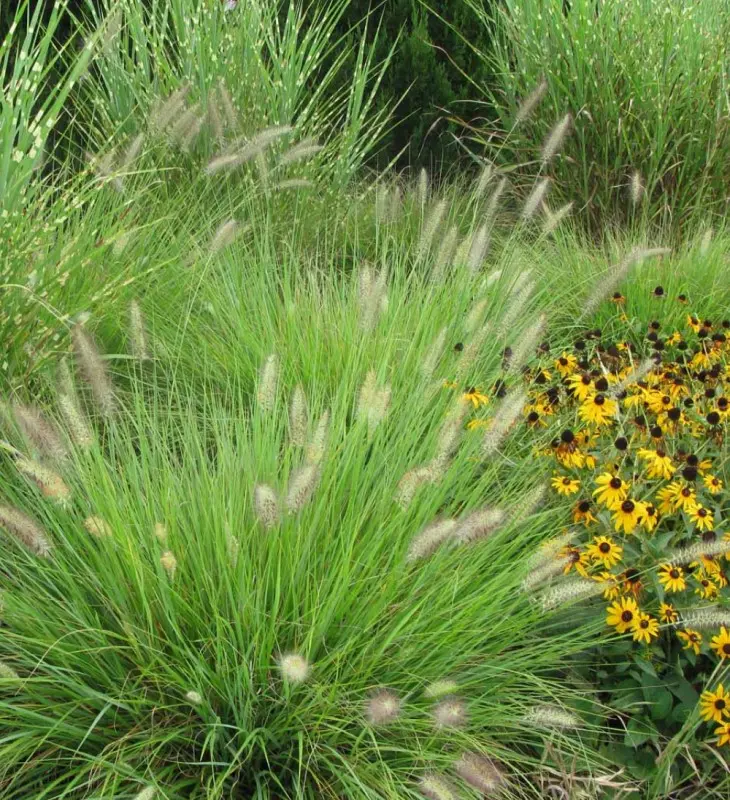
Cassin Grass
$0.00Add to Lawn2'-3'Full sunPartial sunNot deer resistantCassin Grass (Muhlenbergia reverchonii), also known as Seep Muhly, is a graceful ornamental grass native to Texas and other parts of the southern United States. Known for its fine-textured, arching foliage and soft, feathery blooms, Cassin Grass brings an elegant, naturalistic quality to landscapes. In the fall, this grass produces delicate, pinkish-purple flower panicles that create a soft, mist-like effect, similar to Pink Muhly Grass but with a more compact form, making it ideal for smaller spaces or as a subtle accent. Cassin Grass typically grows to about 2 feet tall and wide, forming a rounded, clump-like structure. It thrives in full sun to light shade and is hardy in USDA zones 5-9, making it resilient to both heat and cold. Known for its adaptability, Cassin Grass can grow in a variety of soil types, including rocky or sandy soils, as long as they are well-draining. It is drought-tolerant once established and requires minimal water, making it an excellent choice for xeriscaping or low-maintenance gardens. Ideal for mass plantings, borders, and naturalistic landscapes, Cassin Grass adds texture, color, and movement to any garden setting. Its light, airy plumes are especially striking when backlit by the sun, and its compact, tidy habit makes it a versatile addition to both formal and informal garden designs. Minimal care is needed beyond an annual trim in late winter to encourage fresh spring growth, making Cassin Grass a low-maintenance, eye-catching choice for sustainable landscaping. -

Daylily
$0.00Add to Lawn1'-2'Full sunPartial sunDeer resistantDaylily (Hemerocallis) is a beloved perennial plant known for its vibrant, trumpet-shaped flowers and hardy nature. The name "daylily" comes from the Greek words "hemero" (day) and "kallos" (beauty) because each bloom typically lasts only a day, though the plant continuously produces new flowers throughout its bloom period. Daylilies come in a wide array of colors, including yellow, orange, red, pink, purple, and even bi-color varieties, making them a versatile choice for adding color to gardens. Daylilies form dense clumps of arching, grass-like foliage that ranges from 1 to 4 feet tall, depending on the variety. They thrive in USDA zones 3-9 and perform best in full sun to partial shade, though they can tolerate some shade, especially in hotter climates. These plants are adaptable to a variety of soil types as long as the soil is well-draining, and they are drought-tolerant once established, making them low-maintenance and suitable for many garden styles. Blooming from early summer through fall, daylilies are often planted in borders, mass plantings, or along slopes for erosion control. They also attract pollinators such as butterflies and hummingbirds, enhancing biodiversity in the garden. Care for daylilies is minimal, requiring only occasional watering, deadheading to encourage continuous bloom, and dividing every few years to maintain vigor. With their resilient nature, wide color range, and extended blooming period, daylilies bring reliable beauty and easy upkeep to any landscape. -
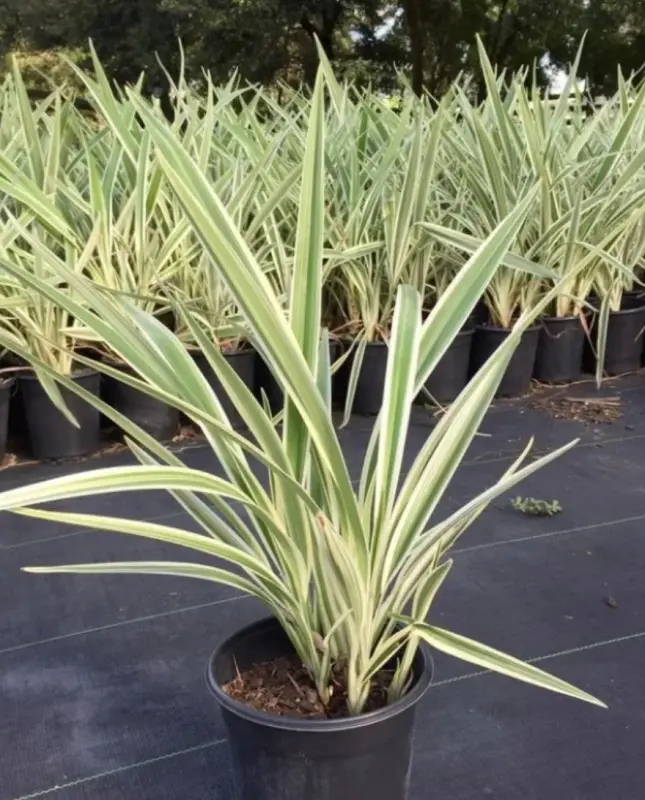
Flax Lily
$0.00Add to Lawn1'-2'Full sunPartial sunNot deer resistantFlax Lily (Dianella tasmanica), also known as Tasmanian Flax Lily, is a versatile, clump-forming perennial known for its strap-like, blue-green foliage and small, star-shaped flowers. Native to Australia, Flax Lily adds a unique, tropical appeal to gardens with its long, arching leaves, which often feature a slight metallic sheen. In spring to early summer, it produces delicate blue or purple flowers on tall stems, followed by striking, iridescent blue berries that provide additional interest through fall. Typically growing 1 to 3 feet tall and wide, Flax Lily is a hardy, low-maintenance plant that can thrive in USDA zones 8-11. It performs best in partial shade to full shade but can tolerate some direct sun, especially in cooler climates. Flax Lily is adaptable to a range of soil types as long as the soil is well-draining, and it is moderately drought-tolerant once established, making it an excellent option for water-wise gardens. Ideal for ground cover, borders, or mass plantings, Flax Lily pairs beautifully with other shade-loving plants and can add a lush, architectural element to shaded areas. It requires little upkeep beyond occasional pruning of dead or damaged leaves and benefits from a layer of mulch to help retain soil moisture. With its unique foliage, delicate blooms, and striking berries, Flax Lily provides year-round interest and is an excellent choice for adding texture and color to shaded landscapes. -
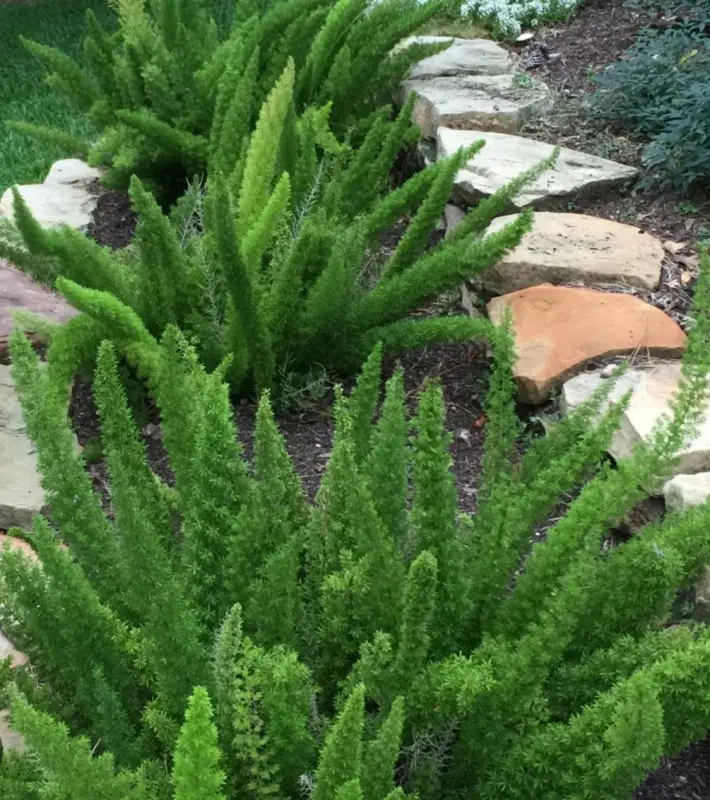
Foxtail Fern
$0.00Add to Lawn2'-3'Full sunPartial sunNot deer resistantFoxtail Fern (Asparagus densiflorus 'Myersii'), also known as Asparagus Fern or Myers Fern, is an eye-catching, tropical perennial prized for its unique, feathery, plume-like fronds. Its vibrant, bright green foliage grows in dense, upright sprays resembling fluffy foxtails, which give the plant its common name. Native to South Africa, Foxtail Fern has a striking, sculptural form that adds texture and structure to garden beds, borders, and containers. This fern typically grows to about 2 to 3 feet tall and wide, forming thick clumps that spread slowly. Foxtail Fern thrives in partial shade to full sun, though it prefers some afternoon shade in hotter climates. Hardy in USDA zones 9-11, it can handle mild frosts but is often grown as an annual or container plant in cooler zones. Foxtail Fern does best in well-draining soil and is relatively drought-tolerant once established, making it suitable for low-water gardens. Regular watering keeps its foliage lush, but it’s essential to avoid overly wet conditions to prevent root rot. Foxtail Fern is low-maintenance and pest-resistant, requiring little more than occasional trimming to remove dead stems or maintain shape. Its dense, evergreen foliage makes it a versatile choice for creating a tropical feel in landscapes or as a striking focal point in pots and planters. Whether used alone or as a textural complement in mixed plantings, Foxtail Fern brings a lush, exotic beauty to both indoor and outdoor spaces. -
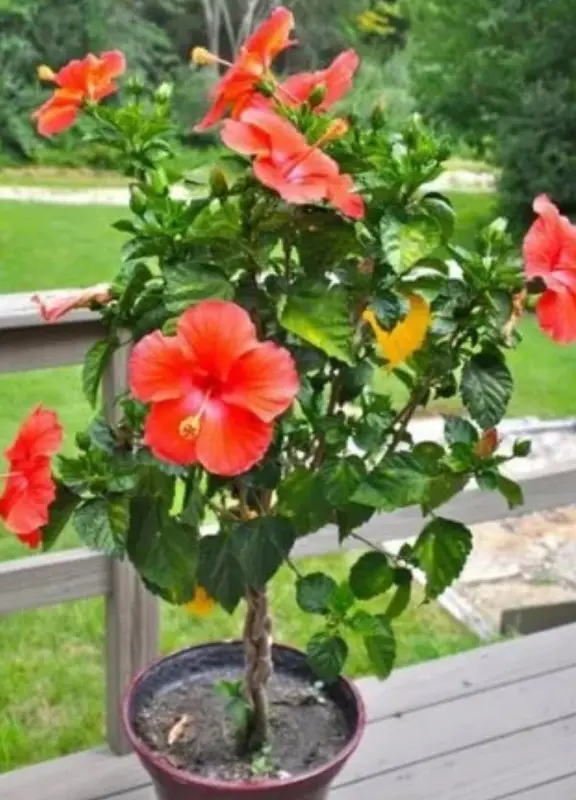
Hibiscus
$0.00Add to Lawn3'-6'Full sunPartial sunNot deer resistantHibiscus is a vibrant, tropical shrub celebrated for its large, showy flowers that bloom in a rich palette of colors, including red, pink, yellow, orange, and white. As a member of the Malvaceae family, hibiscus plants are adored for their lush blooms, which often span 4-6 inches across or more, making them striking additions to gardens and landscapes. Known for thriving in warm, humid climates, hibiscus is commonly grown in tropical and subtropical regions. However, certain hardy varieties, like Hibiscus syriacus (Rose of Sharon), can flourish in colder climates, enduring down to USDA zone 5. Hibiscus plants typically reach heights of 3 to 10 feet, depending on the variety, with a compact, bushy form. Their vibrant blossoms appear from spring through fall, attracting pollinators such as hummingbirds and butterflies. Popular hibiscus types include tropical hibiscus (Hibiscus rosa-sinensis), known for its glossy leaves and continuous blooms in warmer regions, best suited for USDA zones 9-11. Hardy hibiscus (Hibiscus moscheutos) features large flowers, sometimes reaching 12 inches across, and endures colder climates (USDA zones 5-8), dying back in winter and regrowing each spring. Rose of Sharon (Hibiscus syriacus) is a deciduous shrub with an upright growth habit and smaller blooms, ideal for mixed borders or hedging in USDA zones 5-8. Hibiscus thrives in full sun to partial shade and prefers rich, well-draining soil. Regular watering is crucial, particularly in hotter climates, as hibiscus has a higher moisture requirement. For best growth and prolific flowering, hibiscus benefits from a balanced, slow-release fertilizer applied during the growing season. Pruning after the primary blooming season helps maintain shape and encourages new growth for the next cycle. Whether planted in garden beds, containers, or used as decorative hedges, hibiscus adds a tropical and colorful appeal, blending beauty with pollinator-friendly benefits. -
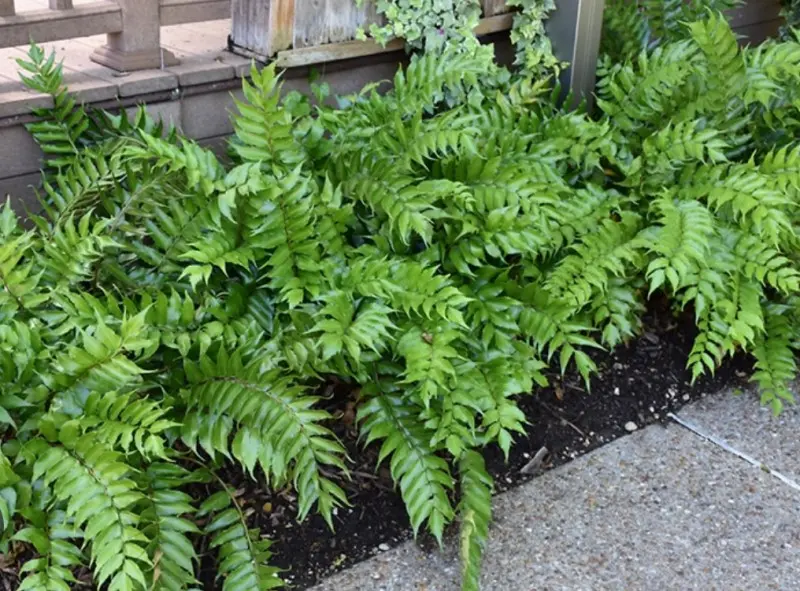
Holly Fern
$0.00Add to Lawn2'-4'Full shadePartial shadeNot deer resistantHolly Fern (Cyrtomium falcatum), also known as Japanese Holly Fern, is an elegant evergreen fern with distinctive, holly-like fronds. Native to Asia, this fern is popular for its shiny, dark green foliage and leathery, toothed leaflets that add a bold texture to shady garden areas. Its fronds can grow 1 to 2 feet tall, with a slightly arching habit, giving it a dense, full appearance ideal for low-light landscapes. Holly Fern thrives in partial to full shade and performs well in USDA zones 6-10. It prefers rich, well-draining soil that retains moisture, making it perfect for woodland gardens or shaded borders. This fern is relatively drought-tolerant once established but performs best with consistent moisture and a layer of mulch to help conserve water. Holly Fern’s hardiness and ability to withstand humidity make it a great choice for humid climates, though it can also handle some cold weather. As a low-maintenance plant, Holly Fern requires minimal care, with occasional pruning to remove any dead or damaged fronds, typically done in late winter or early spring to encourage fresh growth. Its evergreen nature and bold, glossy foliage provide year-round interest in shaded gardens, where it pairs beautifully with other shade-loving plants. Whether used as ground cover, in shaded borders, or as an accent plant, Holly Fern brings texture, durability, and elegance to any shaded area in the landscape. -
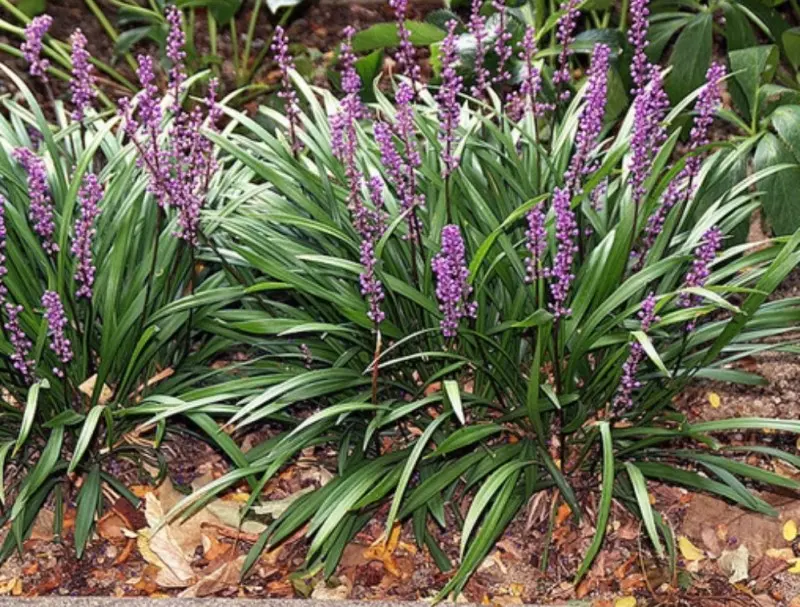
Liriope Grass
$0.00Add to Lawn1'-2'Full sunPartial sunDeer resistantLiriope Grass (Liriope muscari), also known as Monkey Grass or Lilyturf, is a versatile and hardy perennial prized for its dense, grass-like foliage and spikes of delicate, purple or white flowers. Native to East Asia, this plant features arching, strap-shaped leaves that create a lush, low-maintenance ground cover, often reaching 12 to 18 inches in height and spreading equally wide. Liriope’s flowers bloom from late summer to early fall, forming clusters on upright spikes that add visual interest, eventually giving way to small, dark berries that provide additional texture through the cooler months. Liriope thrives in a range of light conditions, from full sun to deep shade, and is hardy in USDA zones 5-10. It prefers moist, well-draining soil but is also drought-tolerant once established, making it adaptable to various landscape settings. Liriope is particularly valued for its ability to suppress weeds, control erosion, and tolerate foot traffic, making it ideal for edging, borders, and even as a lawn alternative in shaded areas. This plant requires minimal care, with an annual trim in early spring to remove any dead foliage and encourage fresh growth. With its low-growing habit, attractive foliage, and seasonal blooms, Liriope is a favorite for adding texture, form, and color to gardens while requiring little attention. Whether used in mass plantings, as an accent, or to line pathways, Liriope Grass brings durability and elegance to landscapes year-round. -
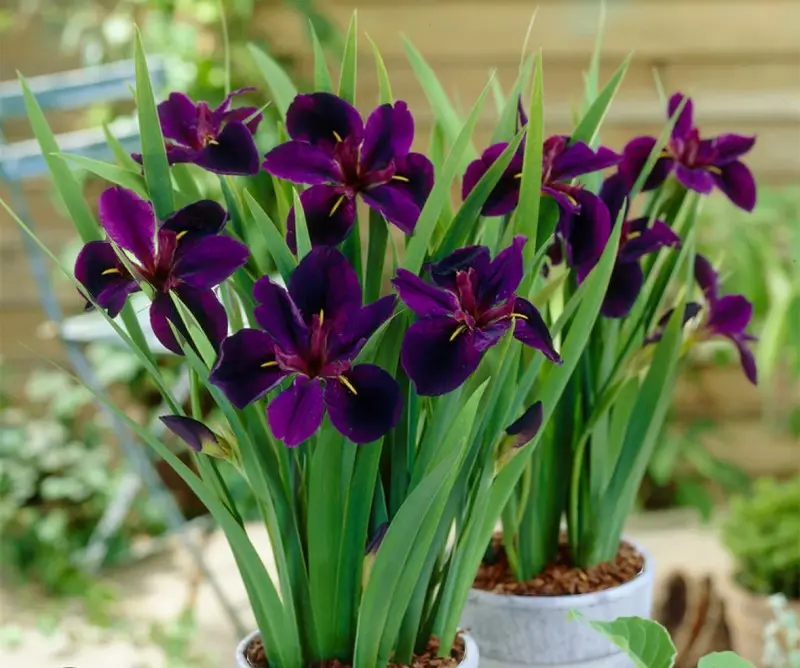
Louisiana Iris
$0.00Add to Lawn2'-4'Full sunPartial sunDeer resistantLouisiana Iris (Iris ser. Hexagonae) is a group of water-loving irises known for their large, colorful blooms and adaptability to wet, humid conditions. Native to the Gulf Coast region of the United States, these irises produce stunning flowers in shades of blue, purple, red, pink, yellow, and white, often with intricate markings. Their showy blooms, which appear in late spring to early summer, feature wide, ruffled petals that add a dramatic and exotic touch to landscapes. Louisiana Irises grow 2 to 4 feet tall and are well-suited to USDA zones 6-10. They thrive in full sun to partial shade and perform best in rich, consistently moist to wet soil, making them ideal for planting along ponds, streams, or in rain gardens. While they prefer wetter areas, they can also tolerate average garden soil as long as it remains consistently moist, particularly during their growing and blooming seasons. These irises are low-maintenance, but occasional fertilizing in spring and a light pruning after blooming can encourage healthier plants and better flowering. Louisiana Irises are often used in bog gardens, water features, and naturalized settings, where they bring color and beauty while supporting local ecosystems. With their striking appearance and tolerance for wet soils, Louisiana Irises are a wonderful choice for gardeners looking to add vibrant color to waterlogged areas. -
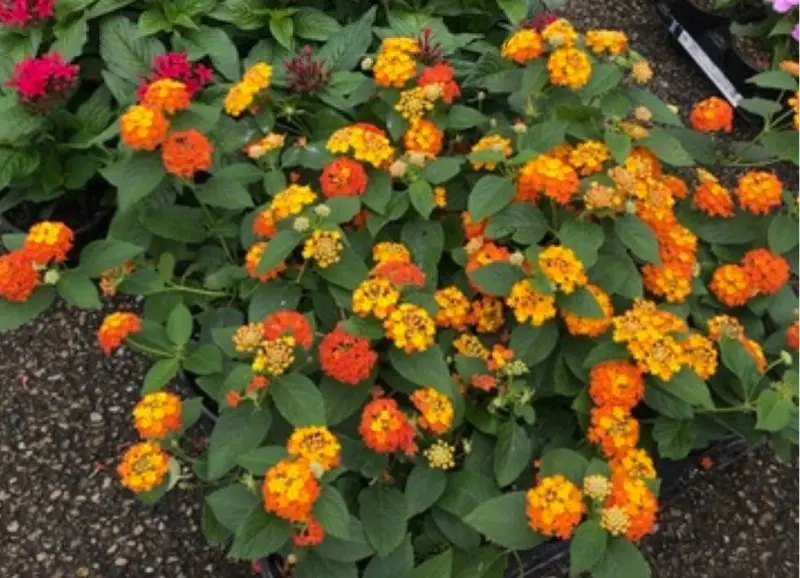
Lucky Lantana
$0.00Add to Lawn1'-2'Full sun-Deer resistantLucky Lantana (Lantana camara), also simply known as Lantana, is a sun-loving perennial prized for its clusters of bright, multicolored flowers and hardy nature. Originating from the tropical Americas, Lucky Lantana blooms in warm hues such as orange, yellow, pink, purple, and red, often transitioning in color as they mature. These small, tubular flowers attract pollinators like butterflies, bees, and hummingbirds, adding life to the landscape throughout its blooming season, which typically lasts from spring through fall. This compact, low-growing variety of lantana reaches around 1 to 2 feet in height and spread, forming dense, rounded mounds of foliage. Lucky Lantana thrives in full sun and is hardy in USDA zones 8-11, though it can also be grown as an annual in cooler regions. Known for its resilience, this plant tolerates heat, humidity, and drought once established, and performs well in well-draining soil. Perfect for garden borders, rock gardens, ground covers, and containers, Lucky Lantana adds a vibrant pop of color to any sunny spot. It is low-maintenance, requiring little more than occasional pruning to encourage new growth and shape, and is resistant to deer and many pests. With its bright, cheerful blooms, drought tolerance, and appeal to pollinators, Lucky Lantana is a popular choice for gardeners seeking a reliable, colorful addition to their outdoor spaces.

